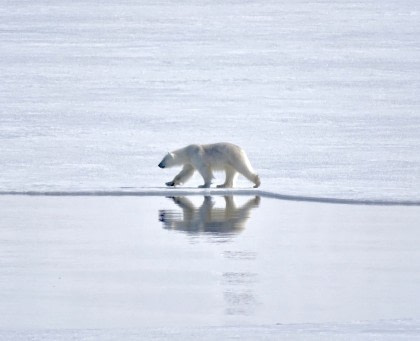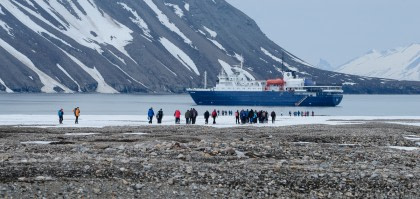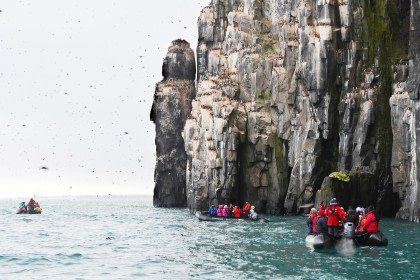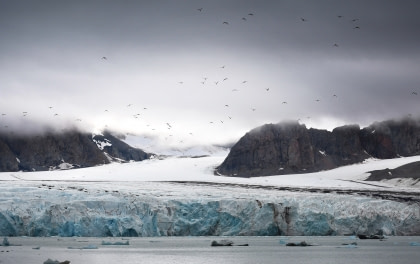Bringing a fading memorial back into focus
Erik Verheul, a senior communications and information systems consultant for the Royal Netherlands Navy, first saw Amsterdam Island in 2008. It was his first trip to the Arctic, but it would not be his last, because what he saw there would inspire him to come back 14 years later to restore a monument erected nearly a century before he was born.
A small island in the Norwegian archipelago of Svalbard, Amsterdam Island lies northwest of the archipelago’s largest island, Spitsbergen, but is among the more historically noteworthy locations in that area. Perhaps most notably, it was the site of one of the archipelago’s earliest whaling settlements, Smeerenburg. Translating literally to “blubber town,” Smeerenburg was established by Dutch and Danish whalers in 1619. The blubber ovens in which the workers used to render sellable oil from the fat of hunted whales can still be seen during our Svalbard trips to that site.
But Amsterdam Island is also known for housing two memorial stones that honor the 17th-century Dutch whalers who died during the early years of the Svalbard whaling boom. One such stone dates to 1906 and is still in fairly good condition. The other, placed in 1878, has suffered the pitiless but inevitable erosion that nearly 150 harsh Arctic winters can deliver. As a result, the names of the men listed on it were barely legible. That is, until Verheul made up his mind to bring them back into focus.

While many people in the Netherlands are still familiar with the culturally significant settlement of Smeerenburg, Verheul’s decision to restore the 1878 memorial stone might seem particularly patriotic. But when we spoke to Verheul about his project, he admitted to no such grand ambitions. Rather, his goal was refreshingly simple: make the 1878 stone legible again so that future visitors can continue to enjoy it.
“My hope is that an interest will be sparked in people who visit the monument or read about the renovation,” said Verheul. “When they dive into the history of Spitsbergen, they’ll find out about all the fantastic stories associated with its history.”
These stories, Verheul explained, are well worth remembering. “The diary of the sailors who wintered on Spitsbergen in those days reads like a thriller, especially because the last one ended in such a tragedy.” The stones honor these stories, commemorating Spitsbergen’s 1596 discovery by Willem Barentsz and marking the years when the two crews wintered there to guard the Smeerenburg whaling facilities.
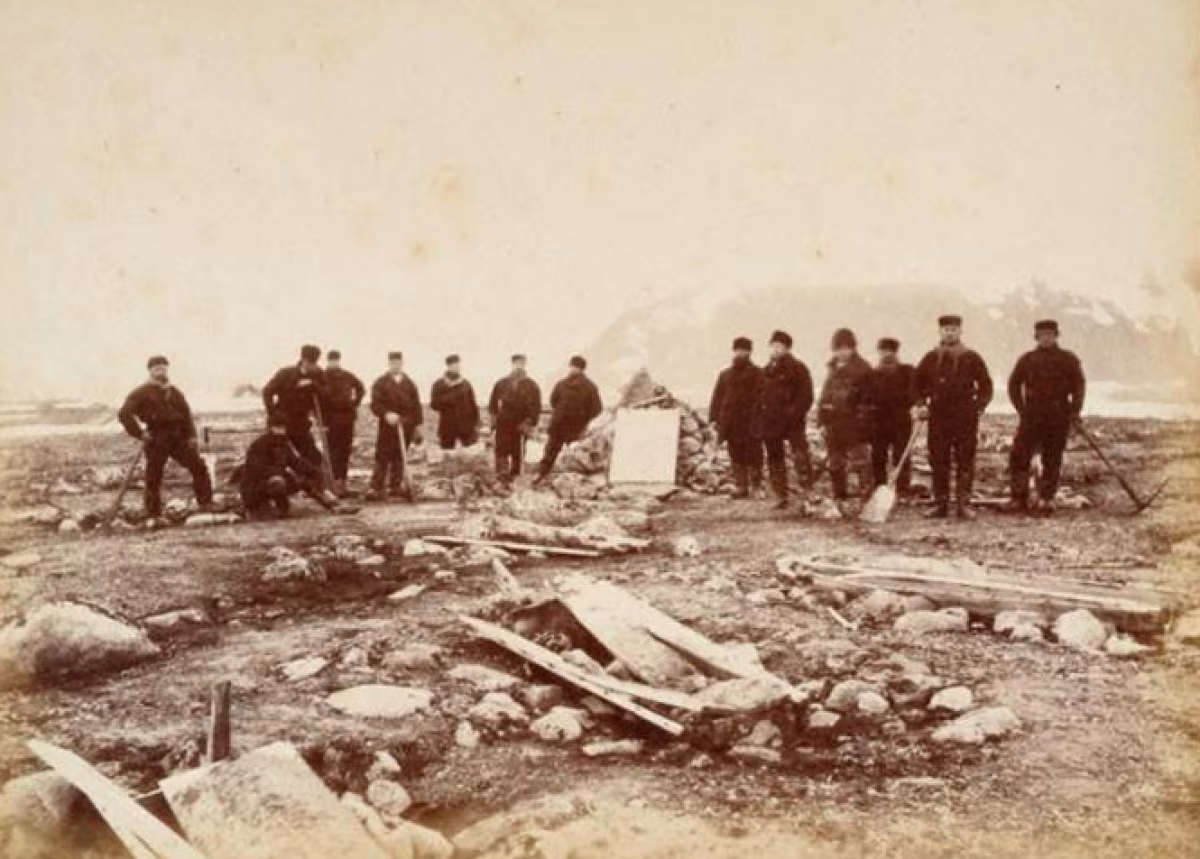
For Verheul, his first time seeing the stones in 2008 was intensely memorable. “We arrived on an old schooner. A cold wind was blowing in our faces while we looked at the whalers grave – a big pile of stones decorated with two memorial stones, one too eroded to decipher. The footprints of a polar bear added to the eerie atmosphere.”
Hearing his description, it’s easy to imagine the moment. It’s also easy to share Verheul’s fascination with the stones. “Strange how just looking at the scene triggered a series of thoughts: Who was buried here? When did this all happen? I would find answers to these questions in libraries and archives in the years to come, but time had almost erased the answers on the stones. That’s when I got the idea for the project.”
The idea would stay in his mind for ten years until he submitted his proposal to the Norwegian government.

Preparation and process of restoring a memorial
After submitting his proposal, Verheul received positive feedback from the Sysselmester (Government of Svalbard) and, in early 2019, permission was given by the Riksantikvaren (Norwegian Directorate for Cultural Heritage) to begin work on the project.
Due to the COVID-19 pandemic, however, travel was halted and the restoration delayed a few more years. So it was not until June 26, 2022, that Verheul at last arrived on Amsterdam Island to begin work, delivered by the Oceanwide Expeditions vessel Hondius.
The first order of business was taking photos to report the current condition of the stones. “At first glance,” he said, “a difference in height between the text and background was still present, so it was immediately clear where the lines of text were positioned. Reading the text, however, was not easy because of the degradation of individual characters.”
“The sharp edges were worn off, making it difficult to determine the shape of the individual letters. And because the softer parts of the stone had eroded more than the harder parts, the surface was uneven and bumpy. This was true for both the text and the background, making it hard to distinguish any details. Some text, especially in the bottom right corner, had vanished.”
There were also, Verheul added, white stains on the surface thought to be bird droppings. These were actually “impurities” in the stone, most likely dolomite. This is common in the Belgium bluestone out of which the memorial was made, a sedimentary stone containing a lot of fossils and other such remains.
The decision was made early to restore the stone with minimal impact. Though reworking the text with a chisel would have yielded longer-lasting results, sanding the characters and defining them with black paint would further preserve the condition of the stone. Verheul used a fine-grain diamond sanding block and special letter paint for this purpose.

Between sanding and painting, he cleaned the surface of the text to remove sanding dust. For this he used a copper brush instead of an iron brush, as iron can introduce rust. “The sanding of the text turned out to be a delicate job,” he said. “Due to the exposure to the elements, the surface was heavily eroded and uneven, and the height of the characters was reduced.”
Since sanding down to an even level would have removed too much of the text, Verheul sanded as little and as carefully as possible. As a result, the text surface remained relatively unequal, with flat sanded spots that made it difficult to paint controlled straight lines and curves. This made the painting take more time than anticipated.
Nevertheless, Verheul was able to complete his work in the time allotted, doing everything at night under the midnight sun. He was accompanied by Oceanwide guides, who gave up their night’s sleep to transport him to the worksite. “At first I was afraid the extra hours would meet with some annoyance from the crew,” said Verheul. “Quite the opposite. They were at least as enthusiastic as I was, so big thanks to OEX and especially the Hondius crew for making this possible.”

Secrets and inconsistencies in the stone versus historic literature
It was during his work that Verheul began to notice several inconsistencies between what is engraved on the memorial stone and what he had found (and even written himself) in the literature about Svalbard’s historic whalers.
While most of these differences are relatively insignificant and probably due merely mistakes in date recording as well as the natural orthographical evolution of language, they do bear mentioning as an example of how fieldwork compares to archival studies. This might seem a small point to some, but it’s not to Verheul – or anyone else who takes historic restorations seriously.
“Letters are all we have on a memorial stone,” he said, “and such a monument is made to memorize them. So in my opinion, the attention to such details is justified. For future restorations, it’s also important to know these details about the original. Current publications do not provide this.”
For example, there exists a disagreement between the coordinates on the stone and those listed in publications. Perhaps the most critical disagreement occurs in the famous journal of Gerrit de Veer, an officer on Willem Barentsz’s second and third voyages to find the Northeast Passage, who provided the first written account of the Novaya Zemlya effect.
De Veer’s journal also recorded the discovery of Amsterdam Island in 1596. “The difference between the stone and journal is subtle,” said Verheul, “but in practice, it means a difference of 29.5 nautical miles, or about 55 km. That’s not nothing.”
Then there is the old-fashioned spelling of “Nieu-Land” on the stone. According to the Dutch Language Institute, nieu was the old version of the Dutch word nieuw, which changed after 1866. The use of the older word is unusual and probably reflects the name on the early maps of the area, not the name in use at the time the monument was made.
Added to these are minor inconsistencies in the formatting of dates and the spelling of certain names, errors that occur both in publications and on the stone itself.
Verheul considers it part of his work to note these instances, even the very small ones. “Not many people are in a position to visit this monument, so they’re usually restricted to publications. I wanted to show that the early publications were not always correct. In fact, none of the publications I could find were entirely correct. People that use them will end up with text that is slightly different than the monument they’re trying to describe. And since parts of the text are now disappearing from the stone, it’s even more important to know what’s on the original.”

What the future holds for the memorial stones
The harsh environment of the Arctic virtually guarantees Verheul’s work will only last for a handful of years before it needs to be repeated. Similar letter paint was also used on a Jan Mayen monument and supposedly lasted for only about five years.
“I’ve contacted the paint supplier to see if they can develop a paint that’s more resilient to Arctic conditions,” said Verheul. “Even if this doesn’t happen, the layer of paint I’ve used will protect the underlying stone structure. Regular maintenance will not only keep the text on the stone readable, it will also contribute to the preservation of the monument.”
We can’t speak for him, but Verheul’s passion for this memorial and frankness about its future make us think it won’t be long before he’s back on Amsterdam Island, diamond sand block and paintbrush close at hand, resurrecting out of a great gray block of Belgian bluestone stone the memory of some of Svalbard’s earliest settlers.


